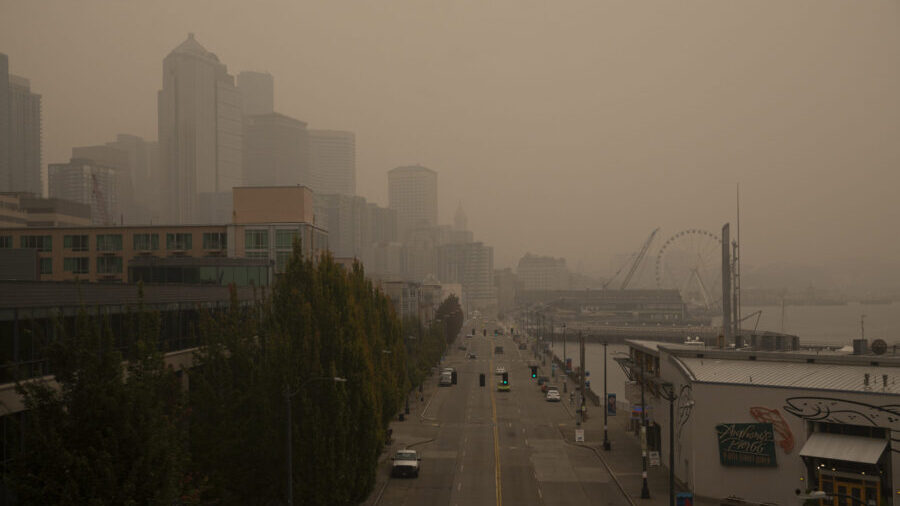
Bad Air Quality in Seattle to Persist, with Worsening Projection

According to IQAir, the Seattle area will experience three weeks of poor air quality this year, with the situation projected to deteriorate further in the coming decades. The issue of air pollution in the region is not limited to wildfire smoke, as fossil fuels are identified as the primary contributor, as explained by IQAir’s CEO, Glory Dolphin Hammes. Compared to other American cities of similar size, Seattle has 10% higher air pollution levels due to industrial sources and the transportation corridor.
Hammes also highlighted fuel-powered vehicles, industry landscaping equipment, and large fireworks shows as significant sources of pollution in the area.
Impact of Wildfires
Hammes emphasized that wildfires will continue to be a major factor contributing to pollution. She noted that wildfires are becoming more frequent and lasting longer, with climate change playing a significant role in this trend.
Past coverage: 11 Washington counties receive ‘F’ grades for air quality
However, IQAir’s 2023 World Air Quality Report indicates that Seattle had cleaner air last year compared to the previous year. The report attributes this improvement, in part, to the implementation of aggressive mitigation strategies, such as the use of technology for early warning systems and increased allocation of ground resources for quicker response.
Seattle witnessed a 36% decrease in annual average PM2.5 levels, while Portland, Oregon experienced an even higher drop at 37%. PM2.5 is one of the six common pollutants monitored and regulated globally by environmental agencies due to its significant impact on human health and the environment, according to IQAir. The Environmental Protection Agency (EPA) acknowledges that PM2.5 particles pose the greatest risk to health.
When air quality is unhealthy, IQAir recommends taking precautions such as wearing a mask both indoors and outdoors, using air purifiers, keeping windows closed to avoid outdoor air, and reducing outdoor exercise.
Contributors to Poor Air Quality
Hammes identified popular holidays like New Year’s and the Fourth of July as “air pollution triggering events” that have a lasting impact on people suffering from respiratory diseases.
For the second consecutive year, IQAir’s report named Columbus, Ohio as the most polluted major city in America, while Las Vegas had the cleanest air among major cities in the U.S. Beloit, Wisconsin was listed as the most polluted city of any size in the country.
More climate coverage: Are we going nuts or is it the environment?
Hammes also highlighted that even if Americans reduce their reliance on fossil fuels, poor air quality will still be a concern due to the increasing number of companies in wealthy countries establishing factories in regions with weaker environmental regulations. She emphasized that air pollution remains a global problem, with other countries contributing significantly to the issue.
IQAir, a technology company based in Switzerland, positions itself as an organization that empowers individuals, organizations, and governments to improve air quality through information and collaboration. The company has partnerships with the United Nations and Greenpeace.
To track air quality in your area, visit IQAir’s website.
Contributing: Diane Duthweiler, KIRO Newsradio; Steve Coogan, MyNorthwest
Julia Dallas is a content editor at MyNorthwest. You can read her stories here. Follow Julia on X, formerly known as Twitter, here and email her here.
SDGs, Targets, and Indicators
-
SDG 3: Good Health and Well-being
- Target 3.9: By 2030, substantially reduce the number of deaths and illnesses from hazardous chemicals and air, water, and soil pollution and contamination.
- Indicator: PM2.5 levels as a measure of air pollution.
-
SDG 11: Sustainable Cities and Communities
- Target 11.6: By 2030, reduce the adverse per capita environmental impact of cities, including by paying special attention to air quality and municipal and other waste management.
- Indicator: Air pollution levels in cities.
-
SDG 13: Climate Action
- Target 13.1: Strengthen resilience and adaptive capacity to climate-related hazards and natural disasters in all countries.
- Indicator: Frequency and duration of wildfires as a result of climate change.
| SDGs | Targets | Indicators |
|---|---|---|
| SDG 3: Good Health and Well-being | Target 3.9: By 2030, substantially reduce the number of deaths and illnesses from hazardous chemicals and air, water, and soil pollution and contamination. | PM2.5 levels as a measure of air pollution. |
| SDG 11: Sustainable Cities and Communities | Target 11.6: By 2030, reduce the adverse per capita environmental impact of cities, including by paying special attention to air quality and municipal and other waste management. | Air pollution levels in cities. |
| SDG 13: Climate Action | Target 13.1: Strengthen resilience and adaptive capacity to climate-related hazards and natural disasters in all countries. | Frequency and duration of wildfires as a result of climate change. |
Analysis:
1. Which SDGs are addressed or connected to the issues highlighted in the article?
The issues highlighted in the article are connected to SDG 3: Good Health and Well-being, SDG 11: Sustainable Cities and Communities, and SDG 13: Climate Action.
2. What specific targets under those SDGs can be identified based on the article’s content?
Based on the article’s content, the specific targets that can be identified are:
– Target 3.9: By 2030, substantially reduce the number of deaths and illnesses from hazardous chemicals and air, water, and soil pollution and contamination.
– Target 11.6: By 2030, reduce the adverse per capita environmental impact of cities, including by paying special attention to air quality and municipal and other waste management.
– Target 13.1: Strengthen resilience and adaptive capacity to climate-related hazards and natural disasters in all countries.
3. Are there any indicators mentioned or implied in the article that can be used to measure progress towards the identified targets?
The article mentions specific indicators that can be used to measure progress towards the identified targets:
– PM2.5 levels as a measure of air pollution.
– Air pollution levels in cities.
– Frequency and duration of wildfires as a result of climate change.
These indicators provide measurable data to assess the progress made in reducing air pollution, improving air quality in cities, and addressing the impact of climate change on wildfires.
By addressing these targets and monitoring the corresponding indicators, progress can be made towards achieving the SDGs related to health, sustainable cities, and climate action.
Behold! This splendid article springs forth from the wellspring of knowledge, shaped by a wondrous proprietary AI technology that delved into a vast ocean of data, illuminating the path towards the Sustainable Development Goals. Remember that all rights are reserved by SDG Investors LLC, empowering us to champion progress together.
Source: mynorthwest.com

Join us, as fellow seekers of change, on a transformative journey at https://sdgtalks.ai/welcome, where you can become a member and actively contribute to shaping a brighter future.






